Design and Construction of General Purpose Computing Resources for Linux Based Computer Science Education

Authors:
- Richard Sharp, Assistant Professor of Computer Science
- Ed Harcourt, Associate Professor of Computer Science
Abstract
For six years our computer science program had no dedicated computing laboratories and limited influence on the software that could be installed on university wide workstations.
In the Fall of 2009 we (the authors) built a computer science laboratory for our CS program from scratch. This includes:
- Physical plant (took over old biology laboratories)
- Hardware/software configurations of workstations and servers.
- Assembly of workstations from components (majority by students).
- A motivation to teach a parallel computing course.
Result is a medium scale computing resource (58 CPUs / GPUs; 232 general purpose computing cores and 12,528 GPU cores) ideal physically located in three classrooms (seating 25, 15, and 12) and a server room. Ideal for classroom, student projects, and single CPU or grid computing.
Go big or go home.
Motivation
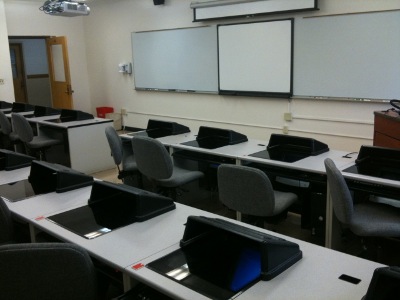
- For six years, our computer science program had no dedicated computing resources.
- Available computing resources were limited to standard university terminals.
- We had limited influence on the kinds of software that could be installed. (Windows based and installed only once a semester with a 2 month pre-notice).
- These restrictions directly affected our ability
to teach computer science in nearly all our courses
except Theory of Computation.
- Regular workstation image.
- Source control.
- Computer graphics.
- Computer networking.
- Operating systems.
- Systems level programming in computer organization.
Requirements
In designing the lab we considered both the educational, computational, and long term administrative requirements of such a project.
Educational
As an undergraduate liberal arts institution, we teach an introductory level CS service course and a major that follows the traditional curriculum for a liberal arts degree in CS. The CS department teaches 15 courses, 5-10 senior research projects, and 1-3 summer student fellowships per year.
We have an average of 10 majors per year (although recently that's been up) and teach about 150 students through our introductory service course. We felt that the design of the lab should take both missions into account.
The computing environment should be exposed to the student as much as reasonably possible for educational purposes. Computer science is about the practical implementation of the theoretical foundations of computation.
Thus, requirements boiled down to this:
- Design a classroom to hold a the maximum number of students. (Pack the service course).
- Upper level courses should be taught in an open and more collaborative environment and allow students flexibility with the environment and hardware.
Administrative
We (the authors), and perhaps you the audience, have have experienced frustration involving the need to install software or configure OS settings for classes but being hampered by bureaucratic processes in a rigid IT service model.
Thus, we wanted a service model that would allow us to make fluid changes to the environment without a go-to person in an IT department.
The only thing we didn't want to touch was maintaining login information (consider a flux of nearly 200 students per year).
Our administrative requirements boiled down to this:
- Type and configuration of software should be decided and implemented by the professor teaching the course.
- Environment should be flexible enough to install software on the fly, during class if necessary.
- Backups should be solid and easily accessible.
- Hardware maintenance should be as painless as possible.
- User access control should be maintained by the central IT department.
- Students should have local CS filespace.
Physical Plant Construction
We were granted "temporary" space in an abandoned section of hallway that once housed part of the biology department.
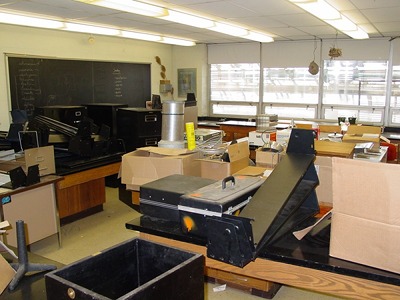
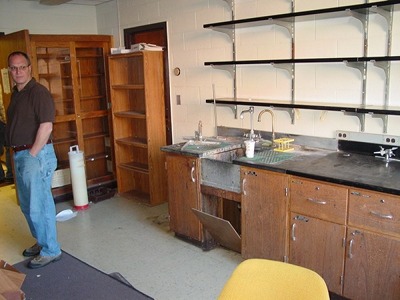
Rooms were filled with garbage, raised laboratory tables, leaking sinks, etc. A major concern to remodeling was the problem of damaging the asbestos tiling.
Keeping our teaching needs in mind, we design two classroom layouts. One for the service course, the other for the introductory level:
-
Upper level classroom with central conference table:
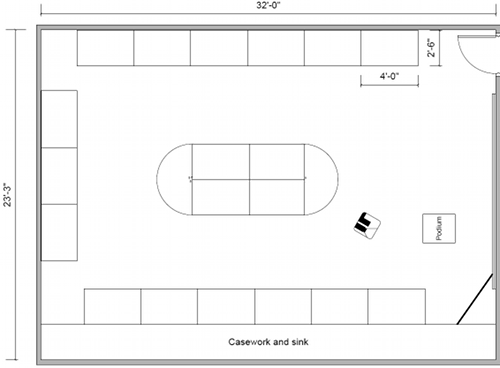
-
Introductory classroom with maximal seating:
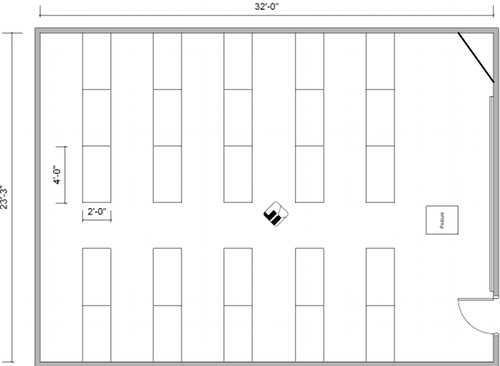
Other physical plant issues we had to consider:
- Data network layout.
- Power needs for each room.
- Classroom stuff: Projector, projector display, podium, whiteboard, furniture.
- After-hours classroom access.
- Air conditioning, 450W * 26 machines plus 26 humans emits around 40000 BTUs per hour. Compare to my woodstove rating of 50000 BTUs per hour.
Hardware Configuration and Construction
We wanted to assemble high quality workstations from components, in part for the learning experience to the students, but also to give us flexibility about how to handle eventual hardware failures.
Workstation configuration:
- Intel i7 2.6GHz 4 core processor.
- 6 GB of RAM.
- NVidia GTX 260 graphics cards.
- 100GB hard drive.
- Gigabit Ethernet.
- Two 17" LCD monitors.
- 450W power supply
As part of the hardware specs, we also bought extra components to replace failures over time. Our general rule of thumb was "15 extra of each". (More on that later).
As part of the educational experience of building the labs we taught a special topics course of which the first three weeks was spent having students assemble workstations.


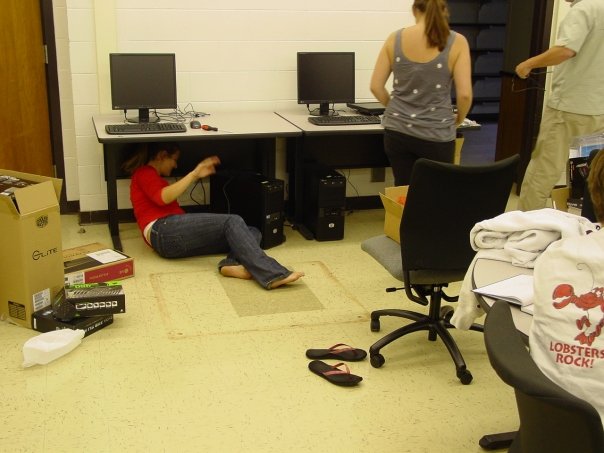
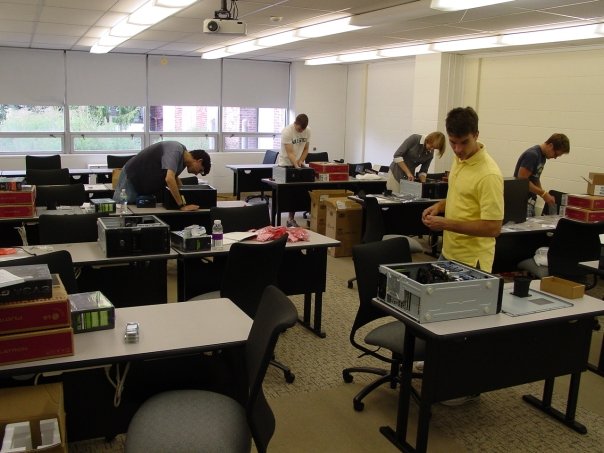
Here's the guts of a workstation:

Software Configuration
We considered Windows and Linux based platforms for our software configurations. We chose Linux because we felt it was a better choice to teach computer science for the following reasons:
- Linux has the potential to expose much of the computing process to the user; ideal for teaching computer science.
- Advanced configurations of the operating system can be achieved, albeit with difficulty. However, once a system is configured, it can be superior in terms of flexibility to a Windows installation.
Currently we are running Ubuntu 10.04 on the workstations and servers.
- File server shares home directories primarily through NFS, but also with Samba for those students who want to mount home directories on a Windows system.
- Access control is handled through a complicated configuration of Kerberos client on each workstation, Samba client to interface with the Windows AD, and a modification to the workstation's PAM (plugable authentication modules) configuration.
- Software can be installed/uninstalled as needed at any time. (More on that later).
Configuring the server/client software was the most difficult part of the entire project.
Maintenance
- Daily monitoring:
- Software updates:
- Cluster SSH is a nice tool for
making parallel updates to all workstations.
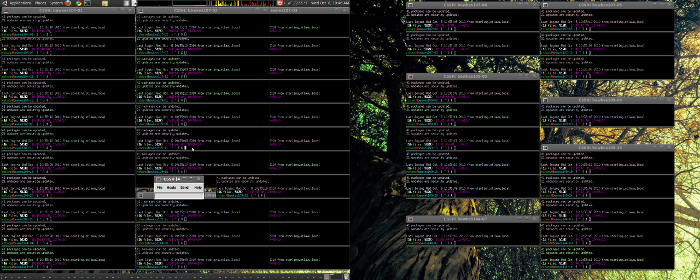
- Use the Debian apt package manager
to install standard packages. For example,
the statistics class needed the R stats
package installed on all machines.
It took all of 5 minutes to cluster ssh
and execute the command
sudo apt-get install r-cran-*
- We maintain a local mirror of all the Ubuntu packages that is updated nightly, so lab-wide installations often only take a few minutes.
- Cluster SSH is a nice tool for
making parallel updates to all workstations.
- Backups:
- Primary file server runs a 2 disk RAID-1 (mirror) on the home folders.
- Primary filer server runs an hourly rsync-like backup called rsnapshot on the root home folder to a separate partition consisting of a 2 disk RAID-1.
- Backup file server does hourly rsync of home folders from primary. Data stored on a 2 disk RAID-1.
- Backup also takes hourly backups using rsnapshot to a 2 disk RAID-1 partition.
- Finally, the backup file server makes backups of its backups to an offsite machine.
- We can switch to the backup file server if the primary fails in minutes. (We change an entry in the /etc/fstab of each workstation to point to the backup file server.)
- Hardware:
- In anticipation of hardware failure, we bought 15 extra of everything. (Power supplies, mother boards, memory, processors, etc.
Final Results
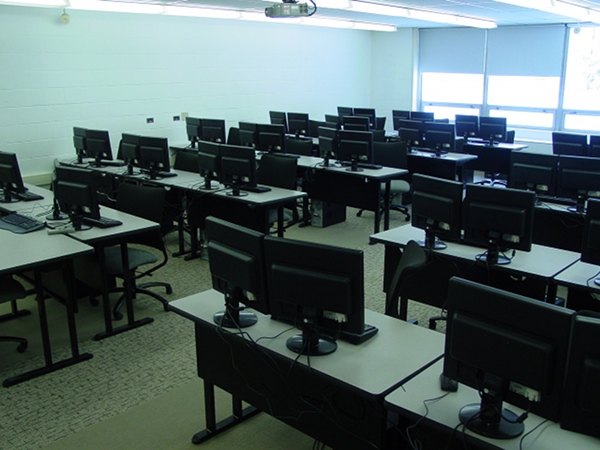
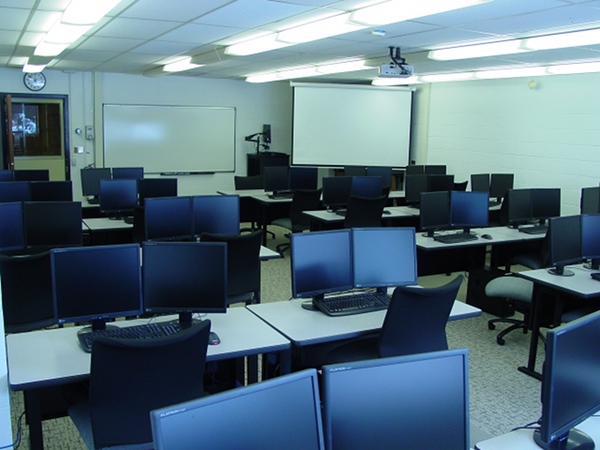
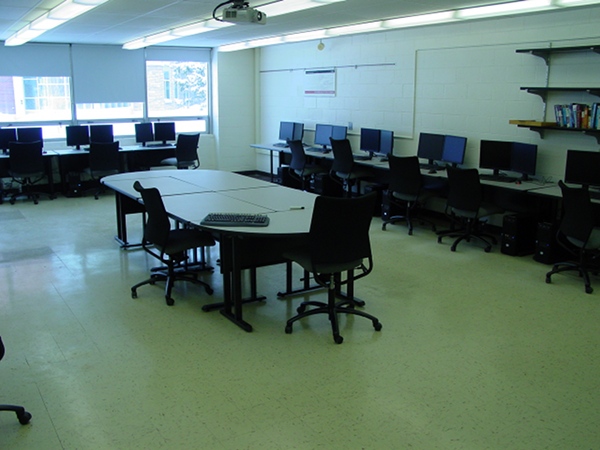

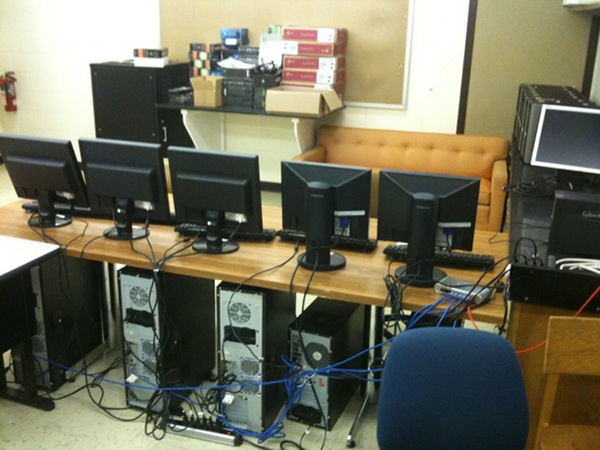
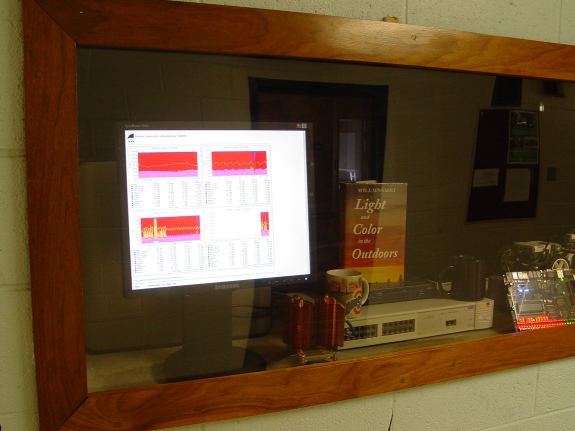
Student Perceptions
Anecdotally, we have had a good reaction to the change in computing environment.
- Students are obviously excited about their hand in the construction of labs. Also gives a bit of ownership to the lower class.
- Higher level students like the switch to Linux and can appreciate command line tricks.
- Introductory students don't have a problem with the environment. (Use terminal in my intro class).
Long Term Observations
- Software management is easier than we imagined. Adding a Python module, Eclipse plugin, or software package has never been a problem.
- Hardware maintenance has been more difficult than expected due to an initial bad batch of graphics cards in the manufacture. This is a good job for IT.
- Never run upgrades in the middle of the semester, if ever.
- Server reliability has been good, as well as monitoring. Recently a hard drive went flaky on the backup file system. We got several emails about it, pulled it, and installed another in about 15 minutes. The operation system rebuilt the RAID-1 and carried on.
- Have used the workstations for several research projects mostly involving parallel Monte Carlo simulations using MPI and CUDA.
- Hardware failures:
- In anticipation of hardware failure, we bought 15 extra of everything. (Power supplies, mother boards, memory, processors, etc.
- After a year of operation, we have seen 3 LCD monitor failures, 2 motherboard failures, > 15 graphics card failures, and one hard disk.
- IT department handles returns.
- Have seen failure rates according to the
classic bathtub curve:

Sources of Potential and Active Funding
- NSF MRI.
- NSF CCLI.
- Private foundations.
- Capital cycle.
Questions
- Happy to answer any questions
- Would also enjoy hearing how your schools handle computing environment.
